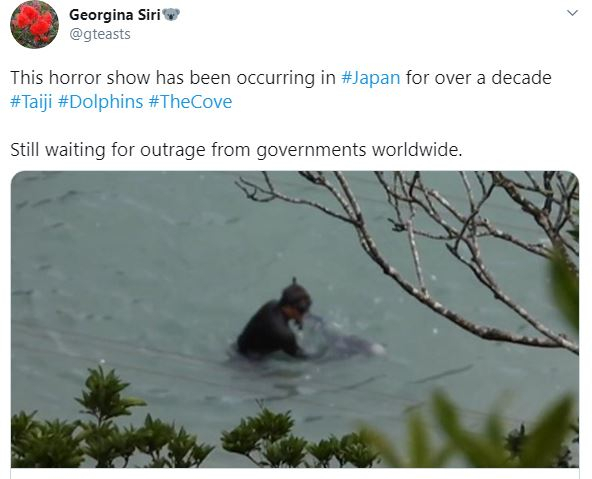Even though environmental experts and activists have raised concerns over the threatening populations of dolphins, whales, and porpoises, there are many people who either don't bother about these inhabitants of earth or just overlook the big picture. Recently, a video of a fisherman, killing a dolphin calf, was widely circulated on social media.
The man has been filmed holding the dolphin calf underwater in Japan's infamous 'Red Cove' before slaughtering the marine creature. The horrific video was actually recorded in September in Taiji, which is a small town in Japan's Higashimuro District.

Another Example of Animal Cruelty
Ren Yabuki, the director of Life Investigation Agency (LIA), which is an animal rights NGO, had witnessed the horrific scene at Red Cove. He estimated that the baby dolphin was hardly three months old when it was killed.
As reported, Yabuki has seen 32 such incidents—the killing of baby dolphins—in the past two years. This time when witnessed the recent juvenile dolphin slaughter case he said that it made his "blood run backward."
As it happened—the man held the dolphin calf underwater, then he dragged it under a tarpaulin and then killed the baby marine animal for its meat. Even though Yabuki did not see when the diver slaughtered the dolphin calf because of the tarpaulin, the animal rights NGO director said that it was likely the marine animal was killed by a method, known as "pithing"—it involves driving a metal rod into the dolphin's back to break the spinal cord.
As per the Japanese government, this horrific and cruel way of killing dolphins is a humane way of slaughtering. But animal activists claim that it is impossible to confirm that animals killed in this way get an easy and instant death, without any suffering. Yabuki said that he had seen multiple calves being killed but "there was no reason the babies are killed more than the bigger dolphins."
Slaughtering of Dolphins Is Seasonal
The dolphin-hunting season in Taiji runs from September 1 to February 28—which means at this point in time some fisherman in that region is killing another dolphin, a creature whose population is in danger. This event was the subject of a critically acclaimed documentary, "The Cove."
Every year, the Japanese government sets a quota for how many such marine animals can be killed, and for the 2020-21 slaughtering season, the number is 1,749. The killing will include species like bottlenose, pantropical spotted dolphins, pacific white-sided dolphins, short-finned pilot whales, striped dolphins, Risso's dolphins, melon-headed whales, and false killer whales. They are mainly slaughtered for the meat or captured to be sold for live trade.
As per an animal rights NGO the Dolphin Project, this year the water in the cove has been turned red six-time due to the mass killing of the marine creatures. In a statement, the Fisheries Agency of Japan's "Whaling Affairs Office" said that the basic policy in Japan is the "sustainable use of aquatic living resources including cetaceans based on scientific evidence."
As per the statement, the FAJ is responsible for the management of these species and has conducted a series of scientific researches on cetaceans. Based on the research results, "it calculates and sets catch quotas for dolphin fisheries species by species every year."
"The FAJ has closely collaborated with relevant prefectural governments for the management of dolphin fisheries, and the dolphin fisheries in Taiji has been properly done so with the Wakayama prefectural government," the statement added.

Understanding the constant threat to these marine species, over 350 scientists as well as conservationists from 40 countries have recently signed a letter urging immediate protection of whales, dolphins, and porpoises from extinction.
Dr. Susan Lieberman of the Wildlife Conservation Society, who also signed the letter said that "it is critical that governments develop, fund, and implement additional needed actions to better protect and save these iconic species - so they don't end going the way of the baiji,"—a freshwater dolphin species, which was common in China's Yangtze River but declared to be 'possibly extinct' in 2017.









